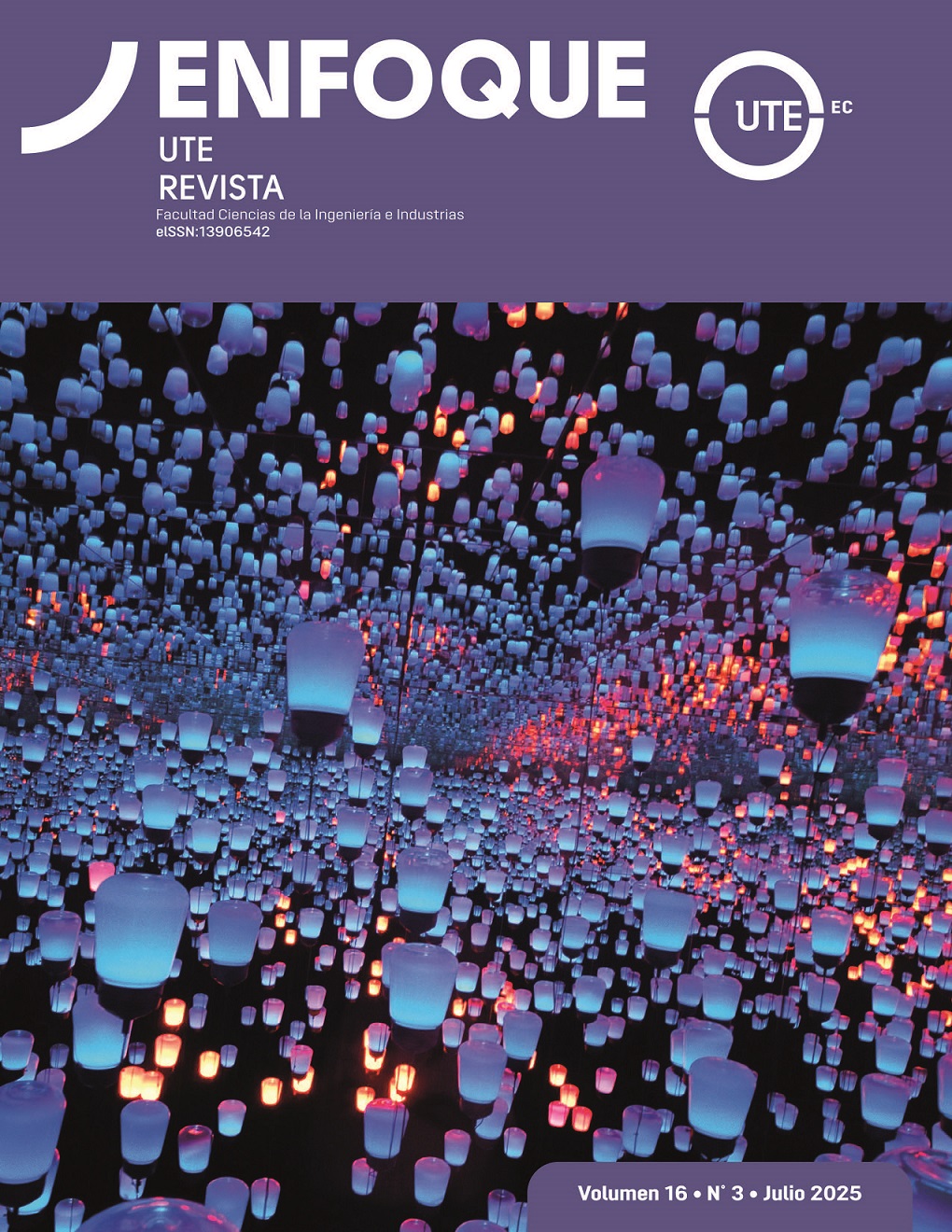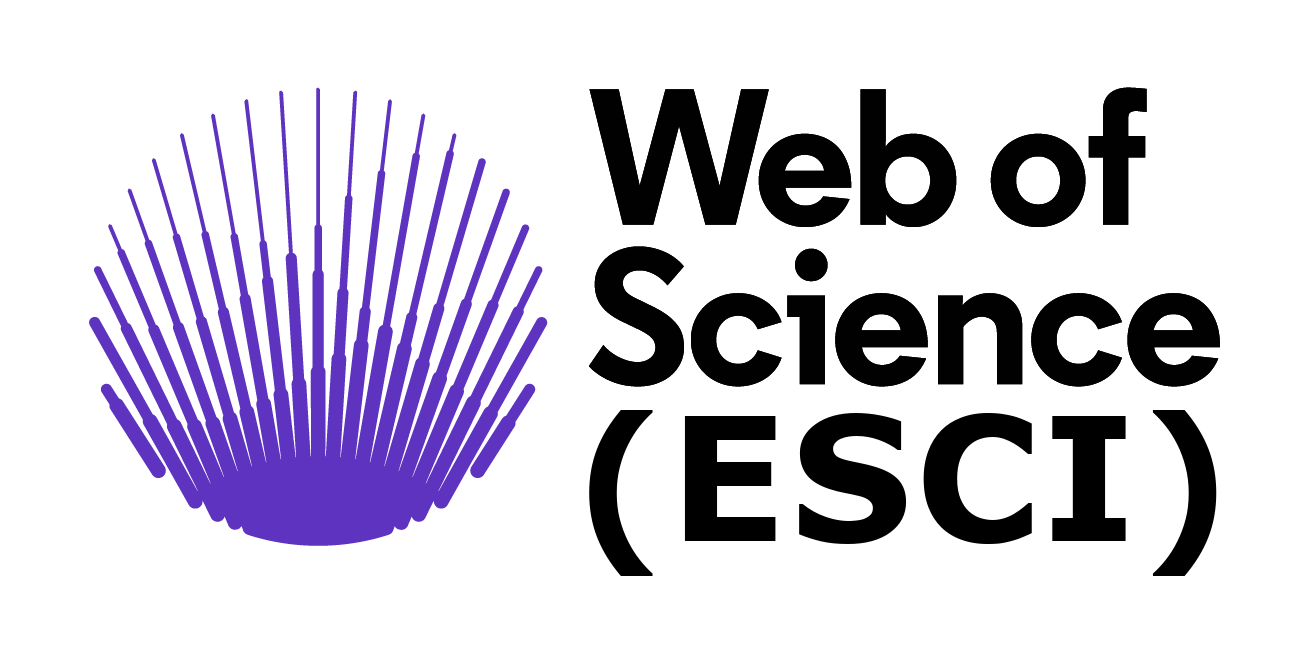Análisis Experimental de la Relación entre Velocidades de Flujo y Transporte de Sedimentos en un Canal de Laboratorio con una Bifurcación Lateral y Lecho de Arena
DOI:
https://doi.org/10.29019/enfoqueute.1150Palabras clave:
bifurcación, velocímetro acústico Doppler (ADV), transporte de sedimentos, flujo en canal abiertoResumen
Este estudio experimental investiga la relación entre las velocidades del flujo y el transporte de sedimentos en un canal de laboratorio con una bifurcación lateral de 90 °, equipado con un lecho móvil compuesto por arena media (D₅₀ = 1.06 mm). El experimento se realizó en el Centro de Investigaciones y Estudios en Ingeniería de los Recursos Hídricos de la Escuela Politécnica Nacional (CIERHI-EPN), utilizando un modelo físico de canal abierto con geometría fija, operado en condiciones de flujo subcrítico y con un caudal constante de 40 l/s. El objetivo es establecer correlaciones empíricas validadas experimentalmente entre las estructuras del flujo y la dinámica del sedimento en canales bifurcados. Se registraron velocidades instantáneas del flujo en más de 180 puntos mediante un velocímetro acústico Doppler (ADV), y se realizaron mediciones topográficas del lecho para cuantificar la socavación y la sedimentación. En total, se socavaron 43.3 l de arena (con una profundidad máxima de 15.01 cm), se redepositaron 8.0 l (con espesores de hasta 8.49 cm), y se transportaron 35.3 l más allá del lecho móvil. Los resultados indican que el flujo es predominantemente unidimensional en el canal de aproximación, mientras que la bifurcación induce componentes tridimensionales del flujo (Vₓ, Vᵧ, V𝓏), asociados a capas de corte, formación de vórtices y redistribución de sedimentos. En comparación con estudios previos que se enfocan en lechos fijos o simulaciones numéricas, esta investigación aporta evidencia experimental de alta resolución sobre la relación entre estructuras de flujo secundario y patrones de transporte de sedimentos en condiciones de lecho móvil. Los hallazgos contribuyen a mejorar la capacidad predictiva del comportamiento morfodinámico en bifurcaciones naturales y respaldan el desarrollo de estrategias más eficientes para el control de sedimentos y el diseño hidráulico.
Descargas
Referencias
[1] C. De Hidráulica, D. María, J. E. Ayala, M. I. José and A. González Verdugo, “Estudio de bifurcaciones en ríos. Informe Final,” Jiutepec, Morelos, 2015.
[2] R. N. Szupiany et al., “Flow fields, bed shear stresses, and suspended bed sediment dynamics in bifurcations of a large river,” Water Resour Res, vol. 48, no. 11, 2012. https://doi.org/10.1029/2011WR011677
[3] R. E. Thomas et al., “An experimental study of discharge partitioning and flow structure at symmetrical bifurcations,” Earth Surf Process Landf, vol. 36, no. 15, pp. 2069-2082, Dec. 2011. https://doi.org/10.1002/esp.2231
[4] I. Ibrahim, S. Legori Ibrahim and S. Khan, “Flow structures in dividing open channels: A review,” in IOP Conference Series: Earth and Environmental Science, Institute of Physics Publishing, Feb. 2020. https://doi.org/10.1088/1755-1315/437/1/012008
[5] A. Momplot, G. Lipeme Kouyi, E. Mignot, N. Rivière and J. L. Bertrand-Krajewski, “Typology of the flow structures in dividing open channel flows,” Journal of Hydraulic Research, vol. 55, no. 1, pp. 63-71, Jan. 2017. https://doi.org/10.1080/00221686.2016.1212409
[6] L. Szewczyk, J. L. Grimaud and I. Cojan, “Experimental evidence for bifurcation angles control on abandoned channel fill geometry,” Earth Surface Dynamics, vol. 8, no. 2, pp. 275-288, Apr. 2020. https://doi.org/10.5194/esurf-8-275-2020
[7] L. Durante, M. Bolla Pittaluga, G. Porcile, and N. Tambroni, “Downstream Control on the Stability of River Bifurcations,” J Geophys Res Earth Surf, vol. 129, no. 10, Oct. 2024. https://doi.org/10.1029/2023JF007548
[8] S. Miori, R. Repetto and M. Tubino, “A one-dimensional model of bifurcations in gravel bed channels with erodible banks,” Water Resour Res, vol. 42, no. 11, Nov. 2006. https://doi.org/10.1029/2006WR004863
[9] T. Y. Dong et al., “Predicting water and sediment partitioning in a delta 1 channel network under varying discharge conditions,” 2020. https://doi.org/10.1029/©2020.
[10] K. Kästner and A. J. F. Hoitink, “Flow and suspended sediment division at two highly asymmetric bifurcations in a river delta: implications for channel stability,” J Geophys Res Earth Surf, vol. 124, no. 10, pp. 2358-2380, Oct. 2019. https://doi.org/10.1029/2018JF004994
[11] M. Bolla Pittaluga, R. Repetto and M. Tubino, “Channel bifurcation in braided rivers: Equilibrium configurations and stability,” Water Resour Res, vol. 39, no. 3, 2003. https://doi.org/10.1029/2001WR001112
[12] S. Kostic and G. Parker, “Formation des deltas de sable et de boue dans les lacs et les réservoirs. 1ière Partie. Théorie et modélisation numérique,” Journal of Hydraulic Research, vol. 41, no. 2, pp. 127-140, 2003, https://doi.org/10.1080/00221680309499956
[13] B. Federici and C. Paola, “Dynamics of channel bifurcations in noncohesive sediments,” Water Resour Res, vol. 39, no. 6, 2003. https://doi.org/10.1029/2002WR001434
[14] M. E. Guevara Álvarez, Socavación en puentes: evaluación, instrumentación y cálculo. Popayán, Colombia: Editorial Universidad del Cauca, 2021.
[15] E. M. Laursen and A. Toch, “Scour around bridge piers and abutments, HR-30 and Iowa Highway Research” in cooperation with THl IOWA State Highway Commission and The Bureau of Public Roads, 1956.
[16] M. Naghavi, M. Mohammadi, G. Mahtabi and J. Abraham, “Experimental assessment of velocity and bed shear stress in the main channel of a meandering compound channel with one-sided blocks in floodplain,” J Hydrol (Amst), vol. 617, p. 129073, Feb. 2023. https://doi.org/10.1016/j.jhydrol.2023.129073
[17] L. Malik and M. A. Matin, “Experimental study on flow and sediment distribution at off-take channel,” International Journal of Environmental Science and Development, vol. 12, no. 2, pp. 35-41, 2021. https://doi.org/10.18178/ijesd.2021.12.2.1315
[18] A. H. Casas and A. Bateman Pinzón, “Experimental and theoretical analysis of flow and sediment transport in 90-degree fluvial diversions,” 2013. Universitat Politècnica de Catalunya.
[19] B. Standard and B. ISO, “Hydrometry—Measurement of liquid flow in open channels using current-meters or floats,” 2007, ISO.
[20] SonTek – a Xylem brand. (2019). FlowTracker2 User’s Manual (Version 1.6). Xylem Inc. https://www.geotechenv.com/Manuals/SonTek_Manuals/sontek_flowtracker2_manual.pdf
[21] S. J. Mclelland and A. P. Nicholas, “A new method for evaluating errors in high-frequency ADV measurements,” 2000.
[22] T. Kostić, Y. Ren and S. Theobald, “3D-CFD analysis of bedload transport in channel bifurcations,” Journal of Hydroinformatics, vol. 26, no. 2, pp. 480-493, Feb. 2024. https://doi.org/1010.2166/hydro.2024.175
[23] M. H. García, Sedimentation Engineering. Reston, VA: American Society of Civil Engineers, 2008. https://doi.org/10 10.1061/9780784408148
[24] P. R. Wilcock and S. T. Kenworthy, “A two‐fraction model for the transport of sand/gravel mixtures,” Water Resour Res, vol. 38, no. 10, Oct. 2002. https://doi.org/10 10.1029/2001WR000684
[25] L. C. van Rijn, “Sediment Transport, Part II: Suspended Load Transport,” Journal of Hydraulic Engineering, vol. 110, no. 11, pp. 1613-1641, Nov. 1984. https://doi.org/1010.1061/(ASCE)0733-9429(1984)110:11(1613)
[26] P. R. Wilcock, “Critical shear stress of natural sediments,” Journal of Hydraulic Engineering, vol. 119, no. 4, pp. 491-505, Apr. 1993. https://doi.org/1010.1061/(ASCE)0733-9429(1993)119:4(491)
[27] W. A. Marra, D. R. Parsons, M. G. Kleinhans, G. M. Keevil and R. E. Thomas, “Near-bed and surface flow division patterns in experimental river bifurcations,” Water Resour Res, vol. 50, no. 2, pp. 1506-1530, 2014. https://doi.org/1010.1002/2013WR014215
[28] K. Hamad Mohamed, “Submerged vanes turbulence: experimental analysis,” 2015.
[29] Y. Wang and A. Jacob Odgaard, “Flow control with vorticity,” Journal of Hydraulic Research, vol. 31, no. 4, pp. 549-562, 1993.
[30] A. Das, B. C. Barman and N. Nandi, “On some aspects of flow characteristics of the bifurcated channel – An experimental approach,” ISH Journal of Hydraulic Engineering, vol. 29, no. 2, pp. 147-153, Mar. 2023. https://doi.org/1010.1080/09715010.2022.2042862.
[31] A. Herrero, A. Bateman and V. Medina, “Water flow and sediment transport in a 90° channel diversion: An experimental study,” Journal of Hydraulic Research, vol. 53, no. 2, pp. 253-263, Mar. 2015. https://doi.org/10 10.1080/00221686.2014.989457
[32] I. Nezu and H. Nakagawa, Turbulence in Open-Channel Flows. Routledge, 2017. https://doi.org/1010.1201/9780203734902
[33] J. L. Best, “Flow dynamics at river channel confluences: implications for sediment transport and bed morphology,” in Recent Developments in Fluvial Sedimentology, SEPM (Society for Sedimentary Geology), 1987, pp. 27-35. https://doi.org/1010.2110/pec.87.39.0027
Descargas
Publicado
Número
Sección
Licencia
Derechos de autor 2025 Los Autores

Esta obra está bajo una licencia internacional Creative Commons Atribución 4.0.
Los autores retienen todos sus derechos (© copyright).
- Los autores retienen sus derechos de marca y patente, y también sobre cualquier proceso o procedimiento descrito en el artículo.
- Los autores retienen el derecho de compartir, copiar, distribuir, ejecutar y comunicar públicamente el artículo publicado en Enfoque UTE (por ejemplo, colocarlo en un repositorio institucional o publicarlo en un libro), siempre que se dé el reconocimiento de su publicación inicial en la revista Enfoque UTE.
- Los autores retienen el derecho a hacer una posterior publicación de su trabajo, de utilizar el artículo o cualquier parte de aquel (por ejemplo: una compilación de sus trabajos, notas para conferencias, tesis, o para un libro), siempre que indiquen la fuente de publicación (autores del trabajo, revista, volumen, número y fecha).
























